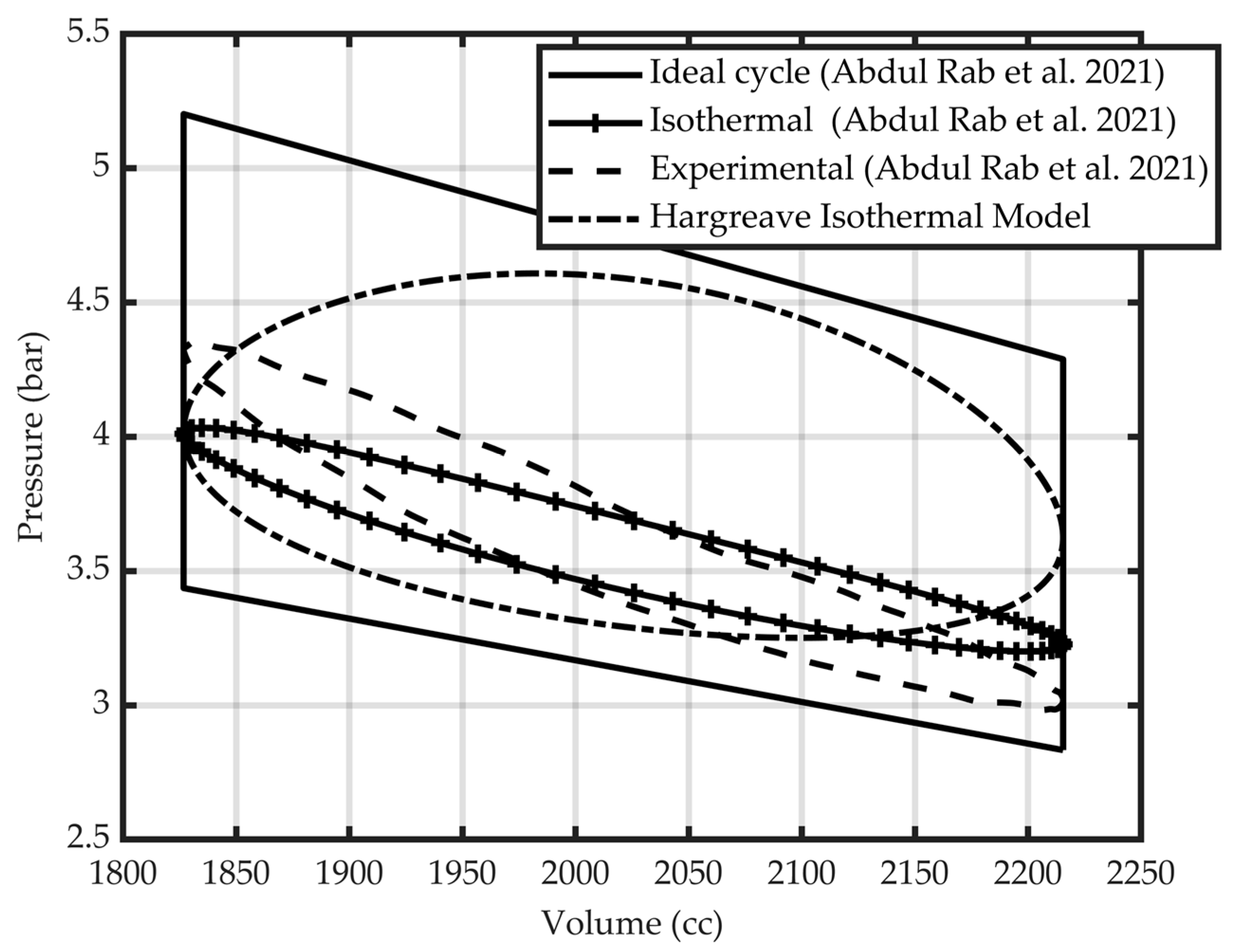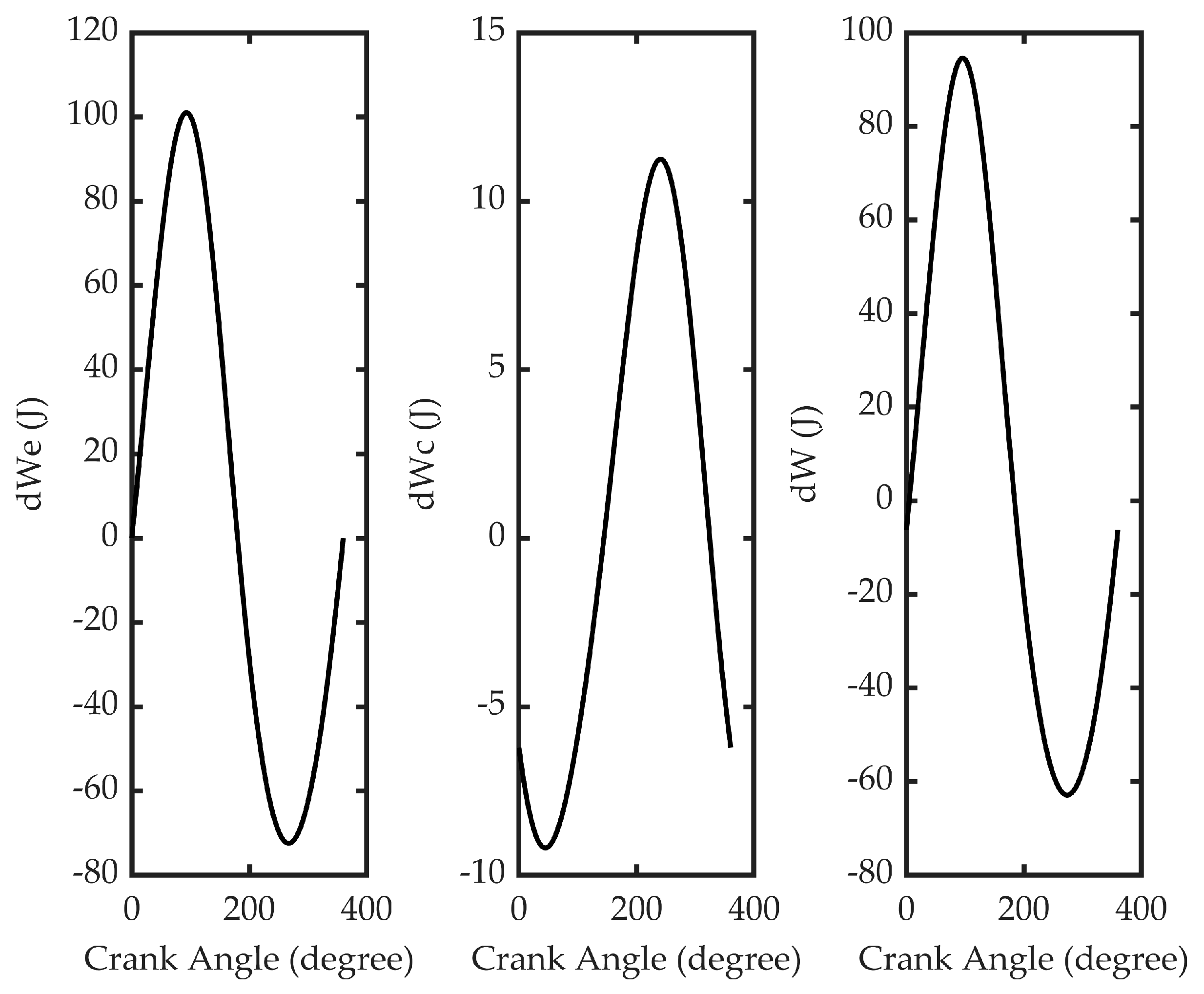A Comprehensive Comparison of the Hargreaves Isothermal Model with the Schmidt Model for the Gamma Stirling Engine †
Abstract
:1. Introduction
2. Engine Data
3. Schmidt Model and Hargreaves Model
4. Results and Discussion
Model Validation
5. Conclusions
Author Contributions
Funding
Institutional Review Board Statement
Informed Consent Statement
Data Availability Statement
Conflicts of Interest
References
- Formosa, F.; Despesse, G. Analytical Model for Stirling Cycle Machine Design. Energy Convers. Manag. 2010, 51, 1855–1863. [Google Scholar] [CrossRef]
- Ahmadi, M.H.; Ahmadi, M.-A.; Pourfayaz, F. Thermal Models for Analysis of Performance of Stirling Engine: A Review. Renew. Sustain. Energy Rev. 2017, 68, 168–184. [Google Scholar] [CrossRef]
- Zare, S.; Tavakolpour-saleh, A.R.; Aghahosseini, A.; Sangdani, M.H.; Mirshekari, R. Design and Optimization of Stirling Engines Using Soft Computing Methods: A Review. Appl. Energy 2021, 283, 116258. [Google Scholar] [CrossRef]
- Zhu, S.; Yu, G.; Liang, K.; Dai, W.; Luo, E. A Review of Stirling-Engine-Based Combined Heat and Power Technology. Appl. Energy 2021, 294, 116965. [Google Scholar] [CrossRef]
- Martini, W.R. Stirling Engine Design Manual; NASA: Cleveland, OH, USA, 1983.
- Li, R.; Grosu, L.; Queiros-Conde, D. Multi-Objective Optimization of Stirling Engine Using Finite Physical Dimensions Thermodynamics (FPDT) Method. Energy Convers. Manag. 2016, 124, 517–527. [Google Scholar] [CrossRef]
- Urieli, I.; Berchowitz, D.M. Stirling Cycle Engine Analysis; Adam Hilger Ltd: London, UK, 1984. [Google Scholar]
- Abdul Rab, A.; Francesco, C.; Bianca Maria, V. Analysis of Thermodynamic Modelling for Gamma Type Double Piston Cylinder Engine. E3S Web Conf. 2021, 313, 08001. [Google Scholar] [CrossRef]
- Wagner, A. Calculations and Experiments on γ-Type Stirling Engines; Cardiff University: Cardiff, UK, 2008; ISBN 1-303-22454-2. [Google Scholar]


| Engine Data | Value | Engine Data | Value |
|---|---|---|---|
| Cooler temperature | 294 | Pressure (bar) | 3.58 |
| Heater temperature | 424 | Rotational speed (rpm) | 882 |
| Cooler void volume | 223 × 10−6 | Phase angle (degree) | 88° |
| Heater void volume | 87.28 × 10−6 | Regenerator void volume (m3) | 308.93 |
| Expansion swept volume (m3) | 221 × 10−6 | Compression swept volume (m3) | 194 × 10−6 |
| Expansion clearance volume (m3) | 24 × 10−6 | Compression clearance volume (m3) | 35 × 10−6 |
Disclaimer/Publisher’s Note: The statements, opinions and data contained in all publications are solely those of the individual author(s) and contributor(s) and not of MDPI and/or the editor(s). MDPI and/or the editor(s) disclaim responsibility for any injury to people or property resulting from any ideas, methods, instructions or products referred to in the content. |
© 2023 by the authors. Licensee MDPI, Basel, Switzerland. This article is an open access article distributed under the terms and conditions of the Creative Commons Attribution (CC BY) license (https://creativecommons.org/licenses/by/4.0/).
Share and Cite
Asary, A.R.; Abdul, B.; Samad, A.; Shibly, M.A.H. A Comprehensive Comparison of the Hargreaves Isothermal Model with the Schmidt Model for the Gamma Stirling Engine. Eng. Proc. 2023, 56, 8. https://doi.org/10.3390/ASEC2023-15246
Asary AR, Abdul B, Samad A, Shibly MAH. A Comprehensive Comparison of the Hargreaves Isothermal Model with the Schmidt Model for the Gamma Stirling Engine. Engineering Proceedings. 2023; 56(1):8. https://doi.org/10.3390/ASEC2023-15246
Chicago/Turabian StyleAsary, Abdul Rab, Basit Abdul, Abdul Samad, and Mohammad Abul Hasan Shibly. 2023. "A Comprehensive Comparison of the Hargreaves Isothermal Model with the Schmidt Model for the Gamma Stirling Engine" Engineering Proceedings 56, no. 1: 8. https://doi.org/10.3390/ASEC2023-15246
APA StyleAsary, A. R., Abdul, B., Samad, A., & Shibly, M. A. H. (2023). A Comprehensive Comparison of the Hargreaves Isothermal Model with the Schmidt Model for the Gamma Stirling Engine. Engineering Proceedings, 56(1), 8. https://doi.org/10.3390/ASEC2023-15246







